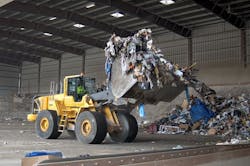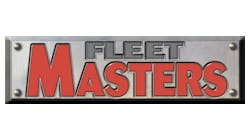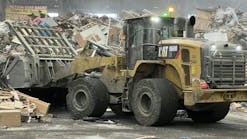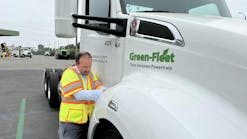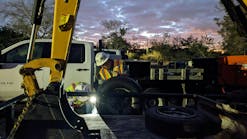When John Meese came to Waste Management in 2007 as senior director of heavy equipment, he had a staff of one, yet he was in charge of the management, maintenance, acquisition, and disposal of 3,797 pieces of heavy equipment at 748 locations scattered nationwide.
Waste Management is a $12 billion company that is more than 24,000 refuse-collection vehicles—it owns hundreds of transfer stations, landfills, and recycling operations, all termed “post-collection” facilities. The diverse list of heavy equipment in these locations includes 395 ADTs, 173 backhoe loaders, 572 dozers, 715 wheel loaders, 199 skid steers, 377 landfill compactors, 446 excavators, and 158 graders with a replacement value in excess of $1 billion.
Waste Management is one of two winners of the 2012 Fleet Masters Award, along with the USAF Europe. The award is presented each year by Construction Equipment and the Association of Equipment Management Professionals (AEMP), and is judged on categories such as finance (financial management, acquisition, warranty and performance guarantees); information management (benchmarking, life-cycle costing, specifications, and technology); policies (safety, employee training, environmental and human resources); and controls (outsourcing, parts management, preventive maintenance, and shop and facilities management).
Adding to those numbers was the daunting fact that Meese literally had no numbers; unlike the refuse collection side of the business, the post-collection operations segment of the company didn’t have a system to gauge and manage its equipment costs properly in place.
“Post-collection operations were largely ignored; there were no good operating cost numbers available to us,” Meese says. “In order to improve something, you have to know what it is today. So we needed to retrain personnel at 275 landfills and 330 transfer stations in operating cost management.”
Meese staffed up with a “Heavy Equipment Fleet Team,” including group managers in four regions of the country and “area” heavy equipment managers under them, also instituting a prescribed business system to teach personnel exactly what to measure.
“Then we established rigid preventive maintenance intervals and tracking, even procedures for cleaning and washing,” Meese says. “What we liken it to is a ‘back to basics’ approach. Waste Management is a company of acquisitions—we had a lot of mom-and-pop operations that needed standardization.”
The far-flung locations of post-collection facilities added to the challenge.
“You can’t be everywhere all the time, so you look at where you can get the largest bang for the buck,” Meese says. “If 80 percent of your spend is at 20 percent of the landfills or transfer stations, you focus on those first, because an improvement there of just 10 percent can be a larger savings than 50 percent saved elsewhere. Go where you can get the most for your time and effort, then pyramid the change management out to the remaining sites.”
Just as the refuse collection side of Waste Management has been at the forefront of CNG use (the company has the largest CNG-powered truck fleet in North America after ingeniously selling the gas drilling rights around some of its landfills and taking the royalties in easily transportable natural gas, not cash), Meese’s post-collection side is an early adopter of diesel-electric technology in heavy iron.
It piloted Caterpillar’s D7E “electric” crawler dozer for 5,200 hours. “We found it burns 40 percent less fuel, and that’s conservative, doing the identical work of a larger tractor,” Meese says. “At the end of 2011, we had five, and we expect to ramp that number up.”
Waste Management has also realized savings through an aggressive machine rebuild program it started in 2007. Partnering with Caterpillar and Cat dealers, the company takes two of the most expensive machine categories it operates, landfill compactors and crawler dozers, and gives them a new life.
“We refined a program Cat had in place,” Meese says. “We narrowed down [the candidates] to 15 Cat dealer partners, and a minimum of two will inspect and then bid on each rebuild. Because we’ve refined things, we know each is bidding apples to apples. It’s then transported to the winning dealer—travel is in the bid.”
Production doesn’t suffer because “swing” machines that have already been finished are often sent to the originating site to keep work going while that site’s machine is rebuilt. It’s all built in to the rebuild deal.
“We get new life at 50 percent of the cost of new machines,” Meese says. “It doesn’t improve the age of the fleet, but it improves the condition of the fleet in an economic way.” Some 400 major pieces of Waste Management heavy equipment have gone through the process so far. Keeping equipment in as peak a condition as possible is a high priority.
“Post-failure repair is always double the cost of catching a problem before it happens,” Meese continues. “So we also do our best to catch a leak early, or to find initial signs of a problem through fluid sampling, versus learning about it post-failure.”
Rebuilds, preventive maintenance, sampling, and a myriad of other efforts, including a contamination control program, making a change from expanded rim to press-on-style solid tires (20- to 30-percent savings), and selling surplus or under-utilized assets (returning almost $19 million in four years), have resulted in significant cost reduction. The maintenance spend alone has been reduced by 22 percent, or $30 million, in four years.
Of course, there’s also less downtime.
“My biggest priority is to not have Field Operations call and say ‘we’re down,’” Meese says. “They’re our customer and we need them to run seamlessly. When they ask a machine to start in the morning and give a full day’s service, that’s our primary concern every day.
“Refuse doesn’t go away, it keeps coming in—environmentally and regulation-wise, keeping equipment working at our sites is a necessity. If we don’t provide equipment for Operations, we’ve failed at our job.”
Five years in, Meese and his team have considerably lessened the chances of that failure.
